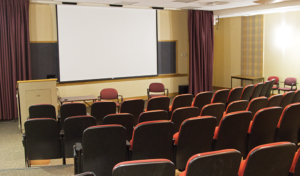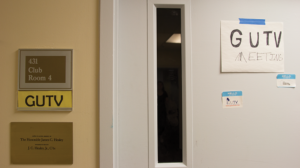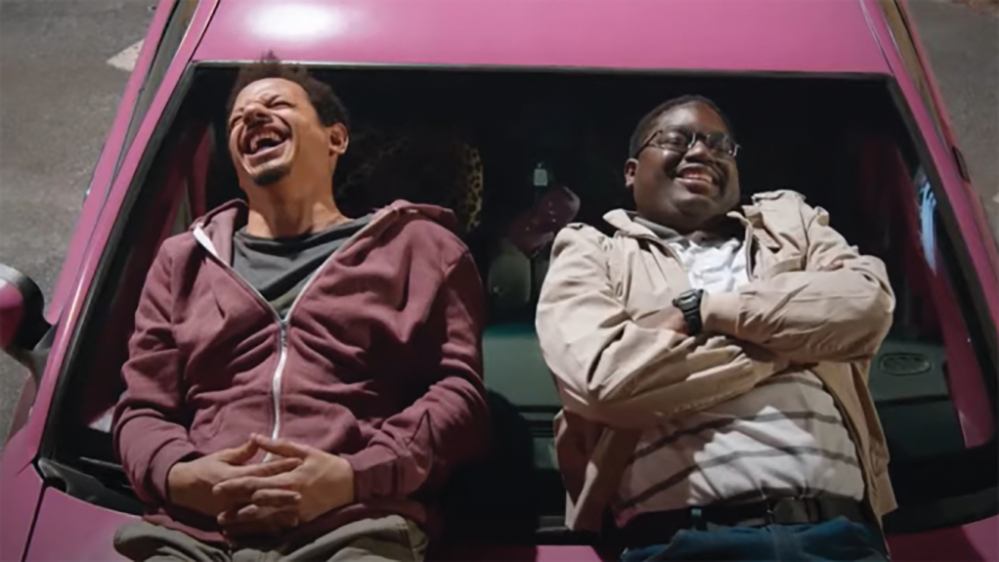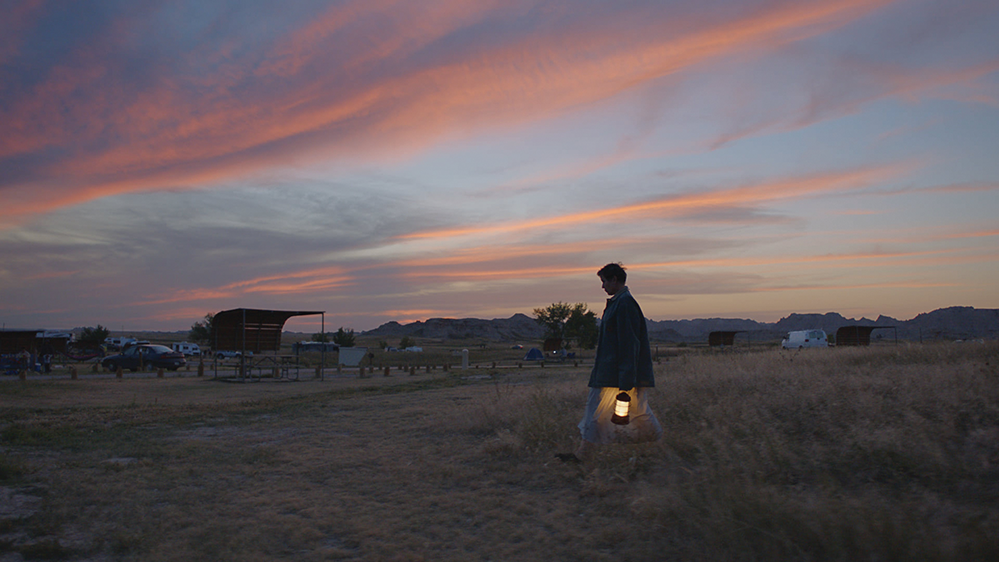In the “Commencement” episode of “ The West Wing,” President Josiah Bartlet addresses a crowd on Healy Lawn for his daughter Zoey’s graduation from Georgetown University. The scene shows the lawn decorated in blue and gray banners, and Georgetown students donning caps and gowns to serve as extras in the background.
“The West Wing” does not provide Georgetown’s only appearance in media. Ever since the university’s 1973 appearance in “The Exorcist,” the university has been a prominent locale for film: Crowds of nervous high schoolers and even more nervous parents, led by chipper Blue & Gray tour guides, often inquire about the location of the infamous “Exorcist Steps.”

Others with more 1980s-oriented tastes wonder about the connection between The Tombs and the bar in the 1985 film “St. Elmo’s Fire.” Alumnus Bradley Cooper (COL ’97) revisited his alma mater just last year, and director Martin Scorsese himself came to campus to talk about his latest film, “Silence,” last April.
Georgetown is more than a set location or a destination for celebrity visits. The university’s film and media studies program, its wealth of alumni in the entertainment industry and its creative student subculture highlight a budding campus film culture.
A Program Is Born
Almost twenty years ago, Bernard Cook (CAS ’90, GRO ’91) — associate dean of the College and a professor in the American studies program — began to realize that many of his Georgetown students had immense talent in film production and analysis. He wanted to create a program for these students to learn more about the industry and express their creativity through media techniques.
Cook’s proposal of a film and media studies minor did not gain traction until former Dean Jane McAullife created the Film and Media Studies Initiative in 2005.
Six years later, the Georgetown College began to recognize that its lack of a film and media studies program was dissuading interested students from attending Georgetown, and started to take the proposed minor seriously.
“I was hearing from students [who] said, ‘Well, I was tempted to go to Northwestern or Brown or Yale or the University of Maryland,’ because they had a program in film and media and we had nothing,” Chester Gillis, former dean of the College, said in a 2016 interview with The Hoya. “We should not be losing students to these other competitive institutions for this particular reason.”
From these concerns came the creation of the film and media studies minor, which was officially implemented by Gillis in spring 2011.

When the program first began, it was limited to 15 to18 students of the College. In more recent years, about 20 students per grade are accepted into the interdisciplinary program, which combines analytical and creative approaches to filmmaking and media to prepare students for a variety of career opportunities after Georgetown.
Besides the traditional “Gateway to Film and Media Studies” and “Introduction to Filmmaking” courses, students in the program must take “Social Justice Documentary” in the spring of their junior year. The course aligns with the program’s goal of investigating the link between media and power and human rights issues. Through the art of documentary, students can create social change and highlight the work of community-based organizations in the Washington, D.C. area.
Students who graduate the program have gone on to work for HBO, NBC, the Smithsonian Channel and various nonprofits.
“Some of our graduates go into the entertainment and media industry in various positions, and some of them are even on their third or fourth job already,” Cook said.
Of the film and media studies minors who graduate each year, a few continue their studies at graduate-level film schools such as the University of Southern California, London Film School and University of Texas, Cook said.
“We’re not expecting people minoring in film and media studies to dedicate the rest of their life to the entertainment business or to documentary or nonprofit media, but we are hoping that in whatever they do, they have a sophisticated understanding of media,” Cook said. “People talk about media literacy — our goal in film and media studies is media fluency.”
From the Hilltop to Hollywood
Whether it be acting, screenwriting or directing, Georgetown alumni have a heavy hand in Hollywood. For students in the film and media studies minor, the program boasts the opportunity to meet with and learn from some of Georgetown’s most successful alumni in the industry.
The film and media studies department regularly hosts master classes for which industry professionals, often alumni, come to Georgetown and engage with students in a panel discussion format.
Most recently, these master classes have included filmmaker Malcolm Lee (COL ’92); documentarian Donn Alan Pennebaker; and key figures behind AMC’s “Breaking Bad,” including Sony Pictures Television President Zack Van Amburg (COL ’92), writer and producer Vince Gilligan and actor Bryan Cranston.
In February, Brit Marling (COL ’05) and Zal Batmanglij (COL ’02) — who met during their time at Georgetown and co-created “The OA,” a critically acclaimed Netflix original series that premiered in December 2016 — will show some seniors in from the “Media Industry Studies” class around their Los Angeles set and answer questions they have about their careers and the entertainment industry in general.
Batmanglij is not the only professional colleague Marling met while at Georgetown. Marling met Mike Cahill (COL ’01) at a Georgetown film festival, and the two began working on short films together. In his senior year at Georgetown, Cahill interned with National Geographic, eventually becoming its youngest field producer, editor and cinematographer.
Cahill is also the only person to have received the Alfred P. Sloan prize at the Sundance Film Festival twice — first for his 2011 film “Another Earth,” and then for his 2014 film “I Origins.”
Other Georgetown alumni involved in the entertainment industry are equally impressive.
Mitchell Hurwitz (CAS ’85), who graduated from Georgetown with a degree in English and theology, is the sole creator of the Fox series “Arrested Development” and co-creator of “The Ellen Show.” HBO’s hit show “Westworld” was co-created by
Georgetown graduate and screenwriter Jonathan Nolan (COL ’99), and the final four Harry Potter films were directed by David Yates (COL ’87).
Starting With Students
Georgetown’s student activities and academic resources enable students to showcase their film and media abilities outside the classroom.
Among student groups focused on film, Georgetown University Television is a campus organization for students interested in learning film production techniques and offers hands-on experience for those wanting to make their ideas come to life.
“GUTV is a film production club first and foremost, so we facilitate in student films and if somebody has an idea they want to make, we’ll try to make that happen. Secondarily, we like to teach people film production,” Ahmed Latif (COL ’19), the head of the organization, said.
Over the past few years, the club has transitioned from producing news media to creative media.
“What’s really nice about clubs like this is that we are able to give people space to work on their creative projects,” Latif said.
Recently, GUTV has produced a short series called “School of Foreign Spies” and has been approached both by Counseling and Psychiatric Services and the Georgetown Mail Services to create professional, informative content.

Students can also showcase their creations every spring at Georgetown University Film Festival, an organization dedicated to promoting short cinematic works from both professional and student creatives. Started four years ago, the festival is largely organized by students enrolled in “ the Film Festival Practicum,” taught by the film and media studies program director Sky Sitney.
When it comes to equipment, the Gelardin New Media Center in Lauinger Library offers free film equipment rentals to any Georgetown student, providing the opportunity for both novice and experienced filmmakers to create movies for classes, student organizations and independent projects.
Although the number of students in the program has remained stagnant since its creation in 2011, Cook is optimistic that as awareness of the program grows, so will its size and opportunities for students.
“I think the student population has gotten stronger and more diverse and more dynamic,” Cook said. “We’ve always had great students in the program, but if anything has changed I think that there’s greater awareness of the program on campus so we’re getting a really wide range of students applying and I think that’s a huge strength of the program.”
Along with the growing number of applicants, the film and media studies program is expanding through its integration of more modern technologies.
“And the world of media is changing daily, so the object of our teaching and research is constantly evolving,” Cook said.



















